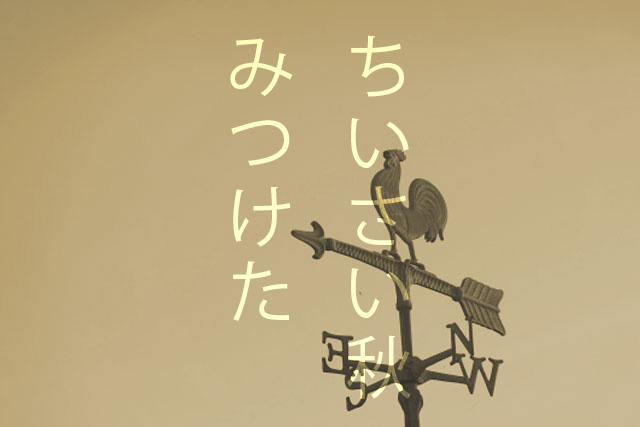Chiisai aki mitsuketa
Darekasan ga darekasan ga darekasan ga mitsuketa
Chiisai aki chiisai aki chiisai aki mitsuketa
Mekakushi onisan teno naru houe
Sumashita omimi ni kasukani shimita
Yonderu kuchibue mozu no koe
Chiisai aki chiisai aki chiisai aki mitsuketaDarekasan ga darekasan ga darekasan ga mitsuketa
Chiisai aki chiisai aki chiisai aki mitsuketa
Oheya wa kitamuki kumori no garasu
Utsuro na me no iro tokashita miruku
Wazukana sukikara aki no kaze
Chiisai aki chiisai aki chiisai aki mitsuketaDarekasan ga darekasan ga darekasan ga mitsuketa
Chiisai aki chiisai aki chiisai aki mitsuketa
Mukashi no mukashi no kazami no tori no
Boyaketa tosaka ni hazenoha hitotsu
Hazenoha akakute irihiiro
Chiisai aki chiisai aki chiisai aki mitsuketaLyricist:SATOU Hachirou
Composer:NAKATA Yoshinao
in 1955
Tiny Autumn found
Someone is,someone is,someone found
Tiny autumn,tyny autumn,Found a tiny autumn I found
Blindfolded “it” playing tag come to the applause
I faintly soaked into my clean ears
Whistling and shrike calling
Tiny autumn,tyny autumn,Found a tiny autumn I found
Someone is,someone is,someone found
Tiny autumn,tyny autumn,Found a tiny autumn I found
The room is north-facing have frosted glass
Hollow eyes, melted milk
The autumn wind blows through a small gap
Tiny autumn,tyny autumn,Found a tiny autumn I found
Someone is,someone is,someone found
Tiny autumn,tyny autumn,Found a tiny autumn I found
Old fashioned weathervane
An old cockscomb with a Japanese wax tree leaf
A single leaf on a blurry top
The leaf is red like the sunset color
Tiny autumn,tyny autumn,Found a tiny autumn I found

Woven like a Poem of Small Scenes
The lively summer breeze begins to carry just a faint scent of autumn. In the Kokin Wakashū, compiled in 905 AD, we find the poem:
Aki kinu to / me ni wa sayaka ni / mienedomo / kaze no oto nizo / odorokarenuru —
“Though the coming of autumn is not yet clear to the eye, one is startled by the sound of the wind.”
This sensitivity to the subtle change of seasons is something deeply Japanese.
The lyrics of Chiisai Aki Mitsuketa (“I Found a Little Autumn”) are written like an epic poem, stacking symbolic fragments of scenery one upon another. The turning of red leaves, the rustle of falling foliage, the voices of children at play—each is cut out like a small vignette, and together they weave a poetic, beautiful world. Listeners can feel the arrival of autumn not in a grand display, but as something that quietly seeps into the heart.

The days when milk meant powdered skim milk. It was dissolved in hot water.
The Childhood Memories of Lyricist SATOU Hachirou
The lyricist, SATOU Hachirou, suffered severe burns as a child and spent a long period hospitalized. In a north-facing hospital room, dim light filtered through frosted glass. From his bed, he could hear the voices of children playing tag outside. A single maple leaf clinging to an old weather vane in the autumn wind—this image etched itself deeply into his heart, reminiscent of O. Henry’s “The Last Leaf.”

O. Henry House in Austin, Texas
Composer Nakata Yoshinao and the Melancholy of Autumn
The words were set to music by composer Nakata Yoshinao. He transformed the loneliness of autumn’s arrival into a transparent, delicate melody. The song’s quiet images, when paired with this tender yet wistful tune, became unforgettable for the Japanese heart. Passed down through generations, it now conveys not only autumn’s solitude but also its gentleness.

A Miracle Born from a Single Radio Program
This song was originally written for a one-time radio program. However, record director OSADA Gyouji was so moved by its beauty that he spent seven years overcoming contractual problems before finally recording it. Without his persistence, this masterpiece might have been lost in the flow of time. The story itself illustrates the importance of preserving art for future generations.
A Monument Standing in Inokashira Park
In Inokashira Park in Kichijoji, a popular town among young people in Tokyo, stands a monument to this famous song. Though the park is lively, in autumn the swaying trees and quiet air bring forth the scenes of “finding a little autumn.” Visitors who stand before the monument may find themselves softly humming the tune.




コメント